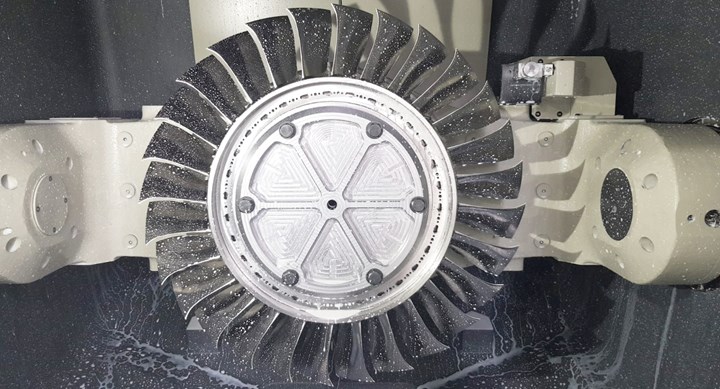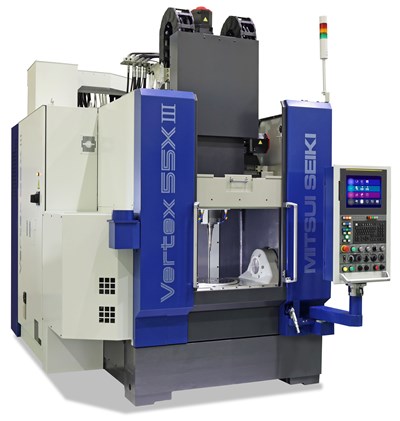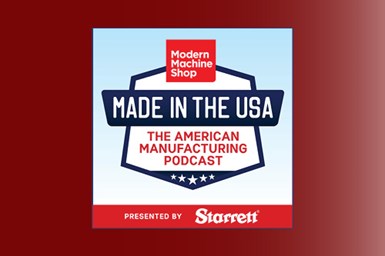Should Blisk Machining be in Your Growth Plan?
Blisk machining offers a great business opportunity but requires technical expertise in machining difficult materials with multi-axis machines. The right partner can help you get started.

The most successful shops take a strategic approach to diversification. This includes growth planning that encompasses consideration of current trends within various market segments and the correlated or inversely correlated relationships between them. It also requires companies to develop a deep, realistic understanding of their own capabilities, then identify areas where their existing competencies would provide an advantage in new ventures.
Over the past year, many manufacturers have eyed the recovering aerospace market as one potential avenue for expansion and diversification. Indeed, it offers tremendous promise for those well-positioned to help meet its rapidly increasing demand. In particular, companies with the right mix of experience and capabilities may find significant opportunity in the realm of blisk manufacturing.
Rising Demand for New Aircraft and MRO
While commercial aerospace took a significant hit in 2020, the resilience of the defense sector helped to blunt some of the impact. In the years since, defense has undergone significant growth, while commercial aircraft has experienced a substantial rebound, leading the overall market beyond previous 2019 highs.

As the defense sector continues to grow the commercial aviation fleet is expected to expand by 33% over the next decade.
Additionally, there are reasons to be optimistic that current trends will hold. Experts predict revenues for commercial travel will surpass 2019 levels next year. Aircraft manufacturers have already ramped up production to meet rising demand, and the global commercial aviation fleet is expected to expand by 33% over the next decade. MRO services are predicted to match that growth rate as well.
Combined, these factors have culminated in demand rapidly outpacing supply for a wide variety of parts and services. Blisks, which are vital components for jet engine operation, have proven especially difficult to procure, as their production requires advanced machine technologies, specialized expertise and stable and reliable processes. For manufacturers able to meet these challenges, blisks offer an opportunity for steady and sustained growth.
A Very Brief Overview of Blisk Manufacturing
Blisks replaced traditional rotors by combining a disk and blades into a single component. Click to view full-size image.
Vital to modern aerospace engines, blisks replaced traditional rotors by combining a disk and blades into a single component, typically falling between 250 mm and 1 m in diameter. This leap forward in jet engine design resulted in stronger, more efficient components, but also made the components more difficult to produce. As is often the case, innovations in engineering resulted in higher hurdles for manufacturers to overcome.
Blisks have always required materials that provide high temperature strength, preferably with as low a weight as possible to maximize efficiency. Inconel and titanium alloys are common, creating issues related to tool life and chip management.
Blisk machining is demanding because of the difficult materials and the geometric complexity of the blades. Click to see full size image.
Early blisks featured blades with simpler geometries, set at an angle, to generate the airflow necessary for jet engine combustion. This design allowed for flank milling of the blades, which kept the challenges somewhat straightforward. Generally, shops that could produce accurate, high-quality parts in difficult-to-machine materials could expect to achieve reasonable success in blisk manufacturing.
In recent years, an increased focus on efficiency has led to the incorporation of complex curved shapes for blisk blades. This dramatically reduced the amount of machining that could be performed via flank milling, leading manufacturers to use point milling to achieve the needed geometries. The shift in design has combined with uncompromising quality requirements and the existing challenges presented by the materials to place blisks among the most challenging components a shop can take on.
Are You Ready to Machine Blisks?
As previously mentioned, the supply chain is currently falling well short of demand when it comes to blisk manufacturing. Shops that successfully move into this area will not only gain an immediate boost to sales and profits, but also a sustainable stream of income for years to come. The high barriers to entry offer a tremendous long-term advantage to those who establish their own capabilities today. But what does it take to make that transition?

Mitsui Seiki Vertex 5-axis VMCs are commonly used for blisk machining and other geometrically complex parts.
First and foremost, experience with difficult-to-machine materials is imperative. Given their long cycle times, high cost of scrap, demanding tolerances and complex geometries, blisks would be effectively impossible to produce without practical expertise in titanium and Inconel alloys. A shop lacking that expertise in-house must find a way, either through partnership or recruiting, to bring it into their process development and implementation.
Likewise, a company wishing to machine blisks should have expertise in quality control and traceability. Given the potential for tragedy that could stem from a flawed component being put into use, the requirements for producing blisks are rigorous. If a company already has a robust process in place for inspecting and documenting parts, it will be well positioned to move into this area. This holds especially true for manufacturers who have adopted advanced metrology equipment and digitalization of their processes.
Establishing blisk manufacturing capabilities also requires a serious commitment from upper management. If it were easy to create and maintain the capability to produce these parts, they would not be nearly as promising of a potential income stream. It takes time to design, implement and fine tune the manufacturing process, and a company’s leadership must be willing to invest the time and capital needed to get it right.
Lastly, partnerships are vital. A shop beginning this journey will need assistance from partners who have already helped others take it. Specifically, manufacturers will benefit from close working relationships with a machine tool builder, cutting tool supplier and CAM software provider, all of whom should have direct experience with blisks.
The Mitsui Seiki Advantage
If you’ve read all of the above and believe your company might be ready to take on blisk machining, there are five clear reasons that it’s worth your time to consult with Mitsui Seiki.
Experience – Mitsui Seiki’s engineering and programming team is comprised of a diverse group of experts, including the world’s foremost applications engineers for blisk manufacturing. We can consult and offer guidance on every aspect of making these parts, from the initial planning to programming to simulation to designing and building fixturing to machine customization to proving out and documenting the production process.
Shown here is Mastercam’s Blade Expert which provides programmers with a wide array of cutting strategies to precisely and efficiently remove material between blades and finish surfaces to ensure Ra requirements can be met.
Partnership – Blisk manufacturing requires specialized knowledge of your machine that you are unlikely to have in-house. For example, the length of the blades can create harmonics that are hugely detrimental to quality. During machine installation, our team tunes a machine’s drives to counteract and eliminate those harmonics. We also identify all vital parts needed to perform preventive maintenance or avoid downtime, then ensure we keep spares of those parts in stock for next-day shipping should a customer need them on short notice.
Technology – Mitsui Seiki Vertex machines are most commonly used for blisk manufacturing due to a variety of standard-setting design features. These machines are built on a box casting and feature trunnion support on both sides to ensure an extremely rigid, stable platform. All mounting surfaces on the casting are hand scraped by technicians who undergo a decade of apprenticeship, resulting in extremely high accuracy. We use Fanuc controls for reliable performance. In the event a machine loses power, an onboard battery pack keeps it running long enough to automatically retract the spindle, so as to not damage a workpiece worth tens of thousands of dollars. We also offer tool hives and automation that allow for long, unattended operation.
Collaboration – As much expertise as Mitsui Seiki maintains in-house, we also recognize the importance of collaborating with other industry leaders. When it comes to blisk production, we routinely partner with the world’s top CAM software and tooling manufacturers, and we also are glad to work with companies at the forefront of technology in other key areas. By doing so, we coordinate the development of a turnkey solution perfectly matched to your operations and applications.
Focus on the Future – Mitsui Seiki’s team is always working to anticipate future needs and have a solution in hand by the time they arrive. For example, in recent years we identified incoming demand for the machining of even larger blisks, up to 1.2 m in diameter. We developed a solution to produce these larger parts and have already made that available. Similarly, when we saw the incoming rise in demand for repair of existing blisks, we developed a platform that combines integrated additive manufacturing, full 5-axis machining and in-process gauging to achieve fully automated repair.
Please visit Mitsui Seiki’s website for more information on Vertex 5-axis machining centers or email msasales@mitsuiseiki.com.







.1692800306885.png)




.1687801407690.png)
